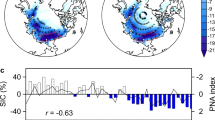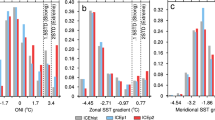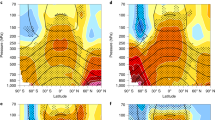Abstract
The pace of Arctic warming is about double that at lower latitudes—a robust phenomenon known as Arctic amplification1. Many diverse climate processes and feedbacks cause Arctic amplification2,3,4,5,6,7, including positive feedbacks associated with diminished sea ice6,7. However, the precise contribution of sea-ice loss to Arctic amplification remains uncertain7,8. Through analyses of both observations and model simulations, we show that the contribution of sea-ice loss to wintertime Arctic amplification seems to be dependent on the phase of the Pacific Decadal Oscillation (PDO). Our results suggest that, for the same pattern and amount of sea-ice loss, consequent Arctic warming is larger during the negative PDO phase relative to the positive phase, leading to larger reductions in the poleward gradient of tropospheric thickness and to more pronounced reductions in the upper-level westerlies. Given the oscillatory nature of the PDO, this relationship has the potential to increase skill in decadal-scale predictability of the Arctic and sub-Arctic climate. Our results indicate that Arctic warming in response to the ongoing long-term sea-ice decline9,10 is greater (reduced) during periods of the negative (positive) PDO phase. We speculate that the observed recent shift to the positive PDO phase, if maintained and all other factors being equal, could act to temporarily reduce the pace of wintertime Arctic warming in the near future.
This is a preview of subscription content, access via your institution
Access options
Subscribe to this journal
Receive 12 print issues and online access
$209.00 per year
only $17.42 per issue
Buy this article
- Purchase on Springer Link
- Instant access to full article PDF
Prices may be subject to local taxes which are calculated during checkout




Similar content being viewed by others
References
Serreze, M. C. & Barry, R. G. Processes and impacts of Arctic amplification: a research synthesis. Glob. Planet. Change 77, 85–96 (2011).
Pithan, F. & Mauritsen, T. Arctic amplification dominated by temperature feedbacks in contemporary climate models. Nature Geosci. 7, 181–184 (2014).
Bintanja, R., Graversen, R. G. & Hazeleger, W. Arctic winter warming amplified by the thermal inversions and consequent low infrared cooling to space. Nature Geosci. 4, 758–761 (2011).
Taylor, P. C. et al. A decomposition of feedback contributions to polar warming amplification. J. Clim. 26, 7023–7043 (2013).
Cohen, J. et al. Recent Arctic amplification and extreme mid-latitude weather. Nature Geosci. 7, 627–637 (2014).
Burt, M. A., Randall, D. A. & Branson, M. D. Dark warming. J. Clim. 29, 705–719 (2015).
Screen, J. A. & Simmonds, I. The central role of diminishing sea-ice in recent Arctic temperature amplification. Nature 464, 1334–1337 (2010).
Graversen, R. G., Mauritsen, T., Tjernström, M., Källén, E. & Svensson, G. Vertical structure of recent Arctic warming. Nature 451, 53–56 (2008).
Boe, J., Hall, A. & Qu, X. September sea-ice cover in the Arctic Ocean projected to vanish by 2100. Nature Geosci. 2, 341–343 (2009).
Barnhart, K. R., Miller, C. R., Overeem, I. & Kay, J. E. Mapping the future expansion of Arctic open water. Nature Clim. Change 6, 280–285 (2016).
Miller, G. H. et al. Arctic amplification: can the past constrain the future? Quat. Sci. Rev. 29, 1779–1790 (2010).
Barnes, E. A. & Polvani, L. M. CMIP5 projections of Arctic amplification, of the North American/North Atlantic circulation, and of their relationship. J. Clim. 28, 5254–5271 (2015).
Screen, J. A., Deser, C. & Simmonds, I. Local and remote controls on observed Arctic warming. Geophys. Res. Lett. 39, L10709 (2012).
Perlwitz, J., Hoerling, M. & Dole, R. Arctic tropospheric warming: causes and linkages to lower latitudes. J. Clim. 28, 2154–2167 (2015).
Kumar, A. et al. Contribution of sea ice loss to Arctic amplification. Geophys. Res. Lett. 37, L21701 (2010).
Balmaseda, M. A., Ferranti, L., Molteni, F. & Palmer, T. N. Impact of 2007 and 2008 Arctic ice anomalies on the atmospheric circulation: implications for long-range predictions. Q. J. R. Meteorol. Soc. 136, 1655–1664 (2010).
Semenov, V. A. & Latif, M. Nonlinear winter atmospheric circulation response to Arctic sea-ice concentration anomalies for different periods during 1966–2012. Environ. Res. Lett. 10, 054020 (2015).
Overland, J. et al. The melting Arctic and mid-latitude weather patterns: are they connected? J. Clim. 28, 7917–7932 (2015).
Screen, J. A. Arctic amplification decreases temperature variance in northern mid- to high-latitudes. Nature Clim. Change 4, 577–582 (2014).
Mantua, N. J., Hare, S. R., Zhang, Y., Wallace, J. M. & Francis, R. C. A Pacific interdecadal climate oscillation with impacts on salmon production. Bull. Am. Meteorol. Soc. 78, 1069–1079 (1997).
Newman, M., Compo, G. P. & Alexander, M. A. ENSO-forced variability of the Pacific Decadal Oscillation. J. Clim. 16, 3853–3857 (2003).
Schneider, N. & Corneulle, B. D. The forcing of the Pacific Decadal Oscillation. J. Clim. 18, 4355–4373 (2005).
Miller, A. J., Chai, F., Chiba, S., Moisan, J. R. & Neilson, D. J. Decadal-scale climate and ecosystem interactions in the North Pacific Ocean. J. Oceanogr. 60, 163–188 (2004).
IPCC Climate Change 2013: The Physical Science Basis (eds Stocker, T. F. et al.) (Cambridge Univ. Press, 2013).
Notz, D. & Marotzke, J. Observations reveal external driver for Arctic sea-ice retreat. Geophys. Res. Lett. 39, L08502 (2012).
Min, S.-K., Zhang, X., Zwiers, F. W. & Agnew, T. Human influence on Arctic sea ice detectable from early 1990s onwards. Geophys. Res. Lett. 35, L21701 (2008).
Deser, C., Alexander, M. A., Xie, S.-P. & Phillips, A. S. Sea surface temperature variability: patterns and mechanisms. Annu. Rev. Mar. Sci. 2, 115–143 (2010).
Deser, C., Tomas, R. A. & Sun, L. The role of ocean–atmosphere coupling in the zonal-mean atmospheric response to Arctic sea-ice loss. J. Clim. 28, 2168–2186 (2015).
Deser, C., Tomas, R. A., Alexander, M. & Lawrence, D. The seasonal atmospheric response to projected Arctic sea-ice loss in the late 21st century. J. Clim. 23, 333–351 (2010).
Francis, J. A. & Vavrus, S. J. Evidence linking Arctic amplification to extreme weather in mid-latitudes. Geophys. Res. Lett. 39, L06801 (2012).
Rayner, N. A. et al. Global analyses of sea surface temperature, sea-ice, and night marine air temperature since the late nineteenth century. J. Geophys. Res. 108, 4407 (2003).
Kalnay, E. et al. The NCEP/NCAR 40-year reanalysis project. Bull. Am. Meteorol. Soc. 77, 437–471 (1996).
Martin, G. M. et al. The HadGEM2 family of Met Office Unified Model climate configurations. Geosci. Model Dev. 4, 723–757 (2011).
Deser, C., Sun, L., Tomas, R. A & Screen, J. Does ocean coupling matter for the northern extratropical response to projected Arctic sea ice loss? Geophys. Res. Lett. 43, 2149–2157 (2016).
Screen, J. A., Simmonds, I., Deser, C. & Tomas, R. A. The atmospheric response to three decades of observed Arctic sea-ice loss. J. Clim. 26, 1230–1248 (2013).
Acknowledgements
J.A.S. was funded by the UK Natural Environment Research Council (NERC) grants NE/J019585/1 and NE/M006123/1. J.A.F. was supported by NSF/ARCSS grant (1304097) and NASA grant (NNX14AH896). The model simulations were performed on the ARCHER UK National Supercomputing Service. We thank the NOAA ESRL and the UK Met Office Hadley Centre for provision of observational and reanalysis data sets. We also thank D. Ackerley for helping to diagnose the cause of model crashes and C. Deser for commenting on the manuscript before submission.
Author information
Authors and Affiliations
Contributions
J.A.S. and J.A.F. jointly conceived the study. J.A.S. designed and performed the model experiments, and analysed the data. Both authors contributed to the interpretation of the results. J.A.S. wrote the manuscript with input from J.A.F.
Corresponding author
Ethics declarations
Competing interests
The authors declare no competing financial interests.
Supplementary information
Supplementary Information
Supplementary Information (PDF 2065 kb)
Rights and permissions
About this article
Cite this article
Screen, J., Francis, J. Contribution of sea-ice loss to Arctic amplification is regulated by Pacific Ocean decadal variability. Nature Clim Change 6, 856–860 (2016). https://doi.org/10.1038/nclimate3011
Received:
Accepted:
Published:
Issue Date:
DOI: https://doi.org/10.1038/nclimate3011
This article is cited by
-
Differing roles of North Atlantic oceanic and atmospheric transports in the winter Eurasian Arctic sea-ice interannual-to-decadal variability
npj Climate and Atmospheric Science (2024)
-
Decoupling of Arctic variability from the North Pacific in a warmer climate
npj Climate and Atmospheric Science (2023)
-
Important role of stratosphere-troposphere coupling in the Arctic mid-to-upper tropospheric warming in response to sea-ice loss
npj Climate and Atmospheric Science (2023)
-
A frequent ice-free Arctic is likely to occur before the mid-21st century
npj Climate and Atmospheric Science (2023)
-
Cold-Eurasia contributes to arctic warm anomalies
Climate Dynamics (2023)



